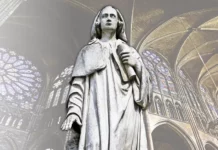In the vivid and captivating descriptions of battles waged and victories won by the young Doctor of the Church, we find valuable teachings for our own sanctification.
“I thank Thee, Father, Lord of Heaven and earth, that Thou hast hidden these things from the wise and understanding and revealed them to babes” (Mt 11:25). These words of Our Lord to the crowd could well be applied to St. Thérèse of the Child Jesus, the humble Carmelite nun who opened a new way of sanctification to future generations: the Little Way.
In proclaiming her Doctor of the Church on October 19, 1997, World Day for Missions, Pope St. John Paul II stressed: “St. Thérèse of Lisieux was unable to attend a university or engage in systematic study. She died young: nevertheless, from this day forward she will be honoured as a Doctor of the Church, an outstanding recognition which raises her in the esteem of the entire Christian community far beyond any academic title.”1
Model of holiness for weak souls
Considering her weakness and the impossibility of sanctifying herself by her own efforts, the young Carmelite surrendered herself to the love of Our Lord, with full confidence in divine mercy, and in a short time she attained perfection. She became a model for all those who feel incapable of imitating the outstanding acts of virtue practiced by the great Saints of Christianity.

St. Thérèse left us the itinerary of her spiritual battles in three texts written under obedience to her superiors, the famous Autobiographical Manuscripts. In them she deftly transmits lofty supernatural realities through simple comparisons, following the example of Our Lord. Let us take a look at some of these parables.
Parable of the flowers of the garden
She had trouble understanding the reason why God granted His graces to souls in such unequal degrees: some received them in such abundance that they conserved their innocence intact their entire lives; others sank into sin, but the Lord, so to speak, obliged them to convert; and others, such as the uncivilized peoples of mission lands, “died in great numbers without even having heard the name of God pronounced.”2 What was the reason for such differences?
Innocent souls are capable of discerning supernatural realities through the simplest creatures. Thus, Sister Thérèse found an answer by looking at the flowers of a garden: all are beautiful, the splendour of the rose and the whiteness of the lily do not deprive the violent of its scent nor the daisy of its charm. Then she understood that “if all flowers wanted to be roses, nature would lose her springtime beauty, and the fields would no longer be decked out with little wild flowers.”3
And she concluded: “And so it is in the world of souls, Jesus’ garden. He willed to create great souls comparable to lilies and roses, but He has created smaller ones and these must be content to be daisies or violets destined to give joy to God’s glances when He looks down at His feet. Perfection consists in doing His will, in being what He wills us to be.”4
From there, she poetically identifies herself with a delicate little flower, in need of God’s constant help. Her parents are compared to two stalks from which eight lilies and a little flower bloomed. The earth did not see four of the lilies blossom: her siblings who died at a young age. The others are her four sisters who helped the little flower at each step, for she was the youngest.
Little flower replanted on Mount Carmel
This little flower grew and soon revealed its spiritual beauty. Having but shortly left her childhood, she already possessed one of the most difficult virtues to acquire: self-renunciation. At the beginning, as she herself said, her face showed the “marks of the battle” waged to conquer this virtue, but later practicing it became easy.

Reading the Imitation of Christ was fundamental in shaping the soul of little Thérèse. She took this book as a sure guide to sanctification, and learned long passages by heart. Strengthened in this way, the little flower was prepared to request her admission to Carmel.
For this, she needed her father’s consent. She could not have chosen a better day to make the request: the Solemnity of Pentecost. After imploring the intercession of the holy Apostles, for she desired with her prayers to be an apostle of apostles, little Thérèse found her father in the tranquil setting of the garden of their home. The rays of the setting sun gilded the treetops as she opened her heart to him. After a moment’s hesitation—due to the tender age of his daughter, who was less than 15 at the time—, he perceived this to be God’s will and gave his assent. He then went over to a low wall, plucked a white flower, similar to a miniature lily, and gave it to his daughter, explaining with what care God had brought it to blossom and preserved it till that day. This was an especially symbolic gesture, for the little flower had been pulled up with its roots, as if to be replanted in another place. Thérèse saw the parable of her life reflected in this simple plant: “This was really the same action Papa had performed a few moments before when he allowed me to climb Mount Carmel and leave the sweet valley which had witnessed my first steps in this life.”5
The Saint of Lisieux kept it between the pages of the Imitation of Christ, at the chapter entitled One must love Jesus above all things. When she wrote her manuscripts, as she neared the threshold of eternity, she perceived that the stem of the symbolic flower had been broken: “God seems to be saying by this that He’ll soon break the bonds of His little flower, not allowing her to fade away on this earth!”6

“I am not an eagle…”
However, what was the specific vocation of Thérèse? As she walked through the cloisters of the convent, she asked herself this question. She ardently desired martyrdom, but that was not enough: she also wanted to be a missionary, doctor, warrior, prophet and apostle. One mission alone did not satisfy her fervour, she yearned to be everything at the same time! Finally, she found the answer in chapters 12 and 13 of the First Letter of St. Paul to the Corinthians: love encompasses all vocations. And she exclaimed, overflowing with joy: “in the heart of the Church, my Mother, I shall be love. Thus I shall be everything, and thus my dream will be realized.”7
Nevertheless, Thérèse was convinced that she was too weak and imperfect for such a sublime vocation. But, this did not constitute an obstacle for her, for her very weakness gave her the audacity to offer herself to Jesus as a victim of love.
Thus, she expressed her situation in Carmel with another beautiful parable: “I look upon myself as a weak little bird, with only a light down as covering. I am not an eagle, but I have only an eagle’s eyes and heart. In spite of my extreme littleness I still dare to gaze upon the Divine Sun, the Sun of Love, and my heart feels within it all the aspirations of an eagle.”8 And thus, seeing herself incapable of flying to be near this Sun, she contemplated it with love here on earth.
As the daring Carmelite fully recognized, in her figurative language, at times the little bird would become distracted by earthly trifles; but she would then return repentant, fix her eyes once again on the Sun and spread her wet wings to be dried in contact with its salutary rays. At such moments, she would have more ardent recourse to the great eagles—the Angels and Saints of Heaven—, who helped her to persevere in love.
But the little bird also knew she was surrounded by deadly vultures—the demons—, who looked for a chance to grab her. She did not fear them, though, for she saw her great protection in the centre of the Sun: the Eternal Eagle, Christ Our Lord, defending her from all the infernal snares.

The Kingdom of Light and the land of darkness
One of the most beautiful parables of the Saint of Lisieux was written during the period in which she suffered terrible temptations against the faith. “One would have to travel through this dark tunnel to understand its darkness,”9 she commented.
In an attempt to convey an idea of the intensity of this trial, the young Carmelite envisions having been born in a country covered in a dense fog, where it is impossible to contemplate the marvels of nature bathed in the rays of the Sun. But she is aware, through intuition and hearsay, that there is a luminous kingdom where everything is excellent and admirable, the true homeland of souls. However, for now, men live in the land of darkness. The King of the luminous country wished to open the eyes of all to the marvels that await them, however many did not want to listen to him: “Alas! the darkness did not understand that this Divine King was the Light of the world.”10
The more she seeks the Kingdom of Light, the more the darkness envelops her, prompting thoughts of despair in her soul: “You are dreaming about the light, about a fatherland embalmed in the sweetest perfumes; you are dreaming about the eternal possession of the Creator of all these marvels; you believe that one day you will walk out of this fog that surrounds you! Advance, advance; rejoice in death which will give you not what you hope for but a night still more profound, the night of nothingness.”11 From time to time, a shaft of light would bring her a little relief, but soon darkness would once again envelope her.
Thérèse never gave in to this temptation. She valiantly confronted the enemy and rightfully declared: “I believe I have made more acts of faith in this past year than all through my whole life.”12 She expressed her joy in suffering for love of Jesus, as well as her willingness to endure even greater woes, if with this she could repair for just one sin against faith.
God’s paint brush
Recognizing the rare virtues of Sister Thérèse, the Superior of that Carmel invited her to be mistress of novices. She did not believe she was worthy of such an office, but obedience helped her to perceive, in the words of the superior, the same order as that given by the Divine Master to St. Peter: “Feed My lambs” (Jn 21:15). Therefore she took on the task with the title of assistant to the Mother Superior, who covered both offices.
In fulfilling this charge, Thérèse soon noted how varied souls are and, above all, how delicate the task of leading them to God can be. How many prayers, how many sacrifices are necessary to do them good! In fact, prayers and sacrifices “are the invincible weapons which Jesus has given me,”13 declared the Saint.
To explain her vision of the role of mistress of novices, the young Carmelite resorted to a simple parable. Could a canvas painted by a great artist think and speak, it would certainly not grumble at receiving successive brushstrokes, nor would it be envious of the brush, a mere instrument in the hands of the painter to whom it owes its beauty. The brush, for its part, could not glory in its work, for, whether a good or bad instrument, what really matters is the skill of the artist. And she concluded: “My dear Mother, I am a little brush that Jesus has chosen in order to paint His own image in the souls you entrusted to my care.”14

Thérèse faithfully fulfilled her difficult assignment. As she had already won many spiritual battles, she was prepared to teach her disciples the way of perfection. “Love is nourished only by sacrifices, and the more a soul refuses natural satisfactions, the stronger and more disinterested becomes her tenderness”15 —she would always say.
Undoubtedly, the humble nun never imagined that the Divine Artist, much more than “touching up” details on the canvas of the souls of the novices of the Carmel of Lisieux, would use that humble little brush to produce works of art in all the nations of the world. In effect, He created the conditions for the sublime teachings of St. Thérèse to be transmitted to successive generations, by means of parables, in the same way as the Divine Master. Actually, according to St. Thomas Aquinas,16 this is a highly effective method for teaching both the wise and the simple.
The parables of St. Thérèse are, moreover, vivid and captivating descriptions of battles waged and victories won by her over the course of her brief existence. Let us profit from the lessons they contain for our own sanctification. ◊
Notes







